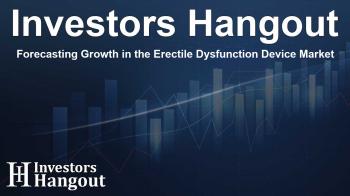Forecasting Growth in the Erectile Dysfunction Device Market

Understanding the Surge in the Erectile Dysfunction Devices Market
The erectile dysfunction devices market is poised for substantial growth, estimated at a compound annual growth rate (CAGR) of approximately 8% by the end of the forecast period. This increase is largely influenced by rising global demand alongside significant advancements in technology. The awareness surrounding erectile dysfunction (ED) continues to illuminate its prevalence, especially among individuals with chronic health challenges like cardiovascular problems, diabetes, and hypertension.
Factors Driving Market Growth
One of the primary drivers of the erectile dysfunction devices market is the escalating incidence of ED, particularly among older men. Many older adults grapple with related health issues, such as prostate cancer, anxiety, and depression, all of which may contribute to erectile dysfunction. Furthermore, the aging population, combined with a rise in obesity rates and lifestyle factors like smoking and lack of exercise, has underscored the necessity for effective ED treatments.
The Role of Technological Advancements
Technological innovation in the erectile dysfunction devices sector has spearheaded numerous new treatment options, significantly improving patient outcomes. Devices range from vacuum erection devices (VEDs) to various types of penile implants. VEDs work by creating a vacuum around the penis, drawing blood into it, while penile implants offer a surgical solution that can provide a more permanent resolution to ED challenges. These advancements not only enhance sexual functionality but have also shown to bolster confidence and uplift quality of life for men suffering from ED.
A Deeper Look into Market Trends
In recent times, North America has emerged as a dominant force in the erectile dysfunction devices market. This trend is driven by increased awareness of ED, major healthcare innovations, and improved access to treatment solutions. Incidents of prostate cancer, high blood pressure, and diabetes remain critical health factors contributing to the rise in erectile dysfunction cases within the region. As technology evolves and new products are developed, the market is expected to witness a surge in growth leading up to 2032.
Regional Insights and Market Dynamics
The North American market, in particular, has been energized by recent developments in the ED devices segment. A prime example includes Comphya SA's recent authorization by the U.S. FDA, which allows them to initiate clinical trials for CaverSTIM, an innovative treatment designed for erectile dysfunction. Such developments signal a promising future, marking the availability of pioneering options for individuals in need of effective treatments.
Challenges and Opportunities
Despite the promising growth trajectory, there are notable challenges restricting wider adoption of these medical devices. The high cost associated with advanced ED devices often places them out of reach for many, particularly in developing regions. Additionally, the complexity of some devices may lead to patient hesitance, further hampering sales. However, these challenges also present opportunities. The push towards advanced technological solutions—such as robotic implantation—is likely to drive the development of more user-friendly devices, further appealing to consumers.
Key Players and Their Strategies
The erectile dysfunction devices market is characterized by the presence of several key players. Companies like Coloplast Group, Boston Scientific Corporation, and others are at the forefront, investing heavily in research and development endeavors aimed at creating innovative solutions tailored to patient needs. Their commitment to enhancing product offerings and exploring strategic partnerships ensures they remain competitive in this dynamic market.
Future Outlook
As we look ahead, the erectile dysfunction devices market is set for continued growth thanks to the integration of cutting-edge technologies and a focus on enhancing patient care. The increasing adoption of tech-enabled solutions in healthcare systems hints at a robust demand for sophisticated erectile dysfunction devices. With a promising outlook, stakeholders and medical professionals must work together to ensure accessibility and education on these indispensable health solutions.
Frequently Asked Questions
What is the expected growth rate of the erectile dysfunction devices market?
The erectile dysfunction devices market is expected to grow at a CAGR of approximately 8% by 2032.
What are the main drivers for growth in this market?
The primary drivers include the rising incidence of erectile dysfunction, advancements in technology, and an increasing elderly population.
Which companies are leading in the erectile dysfunction devices market?
Key players include Coloplast Group, Boston Scientific Corporation, and Zimmer Aesthetics among others.
What challenges does the market face?
High costs of advanced devices and their complexity can hinder widespread adoption.
What opportunities lie ahead for the market?
Upcoming advancements in technology, such as robotic implantation, present significant growth opportunities.
About The Author
Contact Kelly Martin privately here. Or send an email with ATTN: Kelly Martin as the subject to contact@investorshangout.com.
About Investors Hangout
Investors Hangout is a leading online stock forum for financial discussion and learning, offering a wide range of free tools and resources. It draws in traders of all levels, who exchange market knowledge, investigate trading tactics, and keep an eye on industry developments in real time. Featuring financial articles, stock message boards, quotes, charts, company profiles, and live news updates. Through cooperative learning and a wealth of informational resources, it helps users from novices creating their first portfolios to experts honing their techniques. Join Investors Hangout today: https://investorshangout.com/
The content of this article is based on factual, publicly available information and does not represent legal, financial, or investment advice. Investors Hangout does not offer financial advice, and the author is not a licensed financial advisor. Consult a qualified advisor before making any financial or investment decisions based on this article. This article should not be considered advice to purchase, sell, or hold any securities or other investments. If any of the material provided here is inaccurate, please contact us for corrections.

